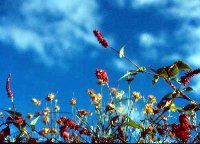
|
Rolwaling, On Your OwnCulture [ Home ] [ Getting There ] [ What to Do ] [ Weather ] [ Culture ] [ Summiters ] [ Full Rolwaling Menu ]
|
|
(Drawn largely from The Sherpas of Rolwaling by Janice Sacherer) In Tibetan, rolwa means "furrow" and ling means "place." The people of Rolwaling believe that their straight narrow valley was plowed out by Padmasambhava, or Guru Urgen Rinpoche, the Indian yogin who brought Buddhism to Tibet. After creating the valley, Guru Rinpoche rested and meditated for three months with his wife and 100 followers. Rolwaling was thereby consecrated as a beyul, or hidden valley, one of one of eight in Nepal, Tibet and Sikkim; in these valleys Guru Rinpoche prophesied that some Buddhists would be able to take refuge from an oppressive government, keeping the faith for more auspicious times. In keeping with this tradition, Rolwaling has been the most conservative of Sherpa valleys. Killing of animals has been forbidden within the valley, although nowadays trekking groups and climbing expeditions frequently buy and slaughter livestock. [See "Letter from a Lama", protesting this practice.] Several holy landmarks and monuments are scattered throughout the valley. Most are connected in some way to Guru Urgen Rinpoche, although some are associated with non-Buddhist gods. Gauri Shankar is the Hindu name for the behemoth to the north: Hindus revere the twin peaks as Shankar (Vishnu) and his consort Gauri. The Buddhist Sherpas worship the same mountain as the abode of Tseringma (Lady Long-Life), the eldest of five divine sisters. The other sisters are reputed to reside on the summits of Sagarmatha, Kanchenjunga, Chobamari and Yalingma. The first gompa (monastery) in Rolwaling was located at Na, which was the earliest Sherpa settlement. At present, the valley’s main religious structure is the Sanga Chholing gompa in Beding, but the gompa at Na is being rebuilt. Several festivals take place at the Beding gompa and other sites around the valley each month.
(Drawn largely from The Sherpas of Rolwaling by Janice Sacherer) While the exact origins of the first Sherpa settlers in Nepal are still disputed, it is widely agreed that the initial wave of immigrants arrived from eastern Tibet in the 1500’s. The first immigrants settled in the nearby Solu region. Later groups trickled in, settling in the higher valleys of Khumbu. Recently a large number of Tibetans have immigrated, and many are assimilated into Sherpa society. Of all the high valleys settled by Sherpas in Nepal, Rolwaling was the last, largely due to its relative inaccessibility and to the fact that it did not lie on the important north-south trade routes. Families from peripheral areas of Sherpa territory were the first to settle in the valley. A large proportion of the original settlers appear to have been fleeing debts or other trouble. The first settlement in the valley was located at Na, named after the only crop at the time: barley. Around the 1880’s potatoes were brought over Tashi Laptsa from Khumbu; this event drastically altered the prevailing agricultural and social systems. Today, potato is essentially the only crop grown in the valley. The relative ease of potato cultivation, and its reliability as a staple crop, led to a population boom and to the construction of the lower winter settlements to the west. A shrine in Beding was enlarged to a full-fledged gompa. The first incursion into Rolwaling Valley by Westerners was in 1951 by the second British Reconnaissance Expedition, lead by Edmund Hillary. Hillary and Ridford approached the valley over the Tashi Laptsa pass while testing oxygen equipment. After spending a few nights on the pass, they descended into the valley and become the first known westerners to set foot in Rolwaling. They returned to Kathmandu via Charikot (Dolakha) and Barabise. A year later, in 1952, another British mountaineering group approached the valley via Barabise, to the west. Present on this Expedition was Tom Wier who wrote East of Kathmandu which included the first written account of the valley. Shipton, Evans and Gregory subsequently approached the valley from Tibet over the Menlung La. Although they were unable to find a way down through the heavily crevased icefield, they were rewarded with the first ever Western encounter with the yeti. Shipton took several famous photographs and sparked a worldwide obsession has continued, somewhat abated, to this day. During the following 12 years, several other expeditions made there way into the valley. These expeditions had primarily primarily scientific and mountaineering objectives. Several attempts were made on Gauri Shankar, although none were successful. In 1964, the valley was closed to Western visitors. Only a handful of individuals were issued special permits to carry out studies of the area. The valley was opened again in 1971 and became a popular destination, not only for mountaineers, but trekkers as well. The Nepalese government once again closed the valley in the 1980s. In the early 1990s it was opened only for groups with a mountaineering or trekking peak permit and accompanied by a register Nepali outfitter. Unofficially, Rolwalling is now open to independent trekkers. There are rumors that trekking permits will soon be required. |